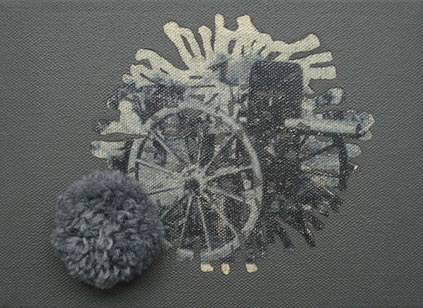| |
Helen MacAlister
Petrified Gossip
23 March - 22 April 2004
Front Room

   
Helen MacAlister makes paintings in which she appropriates particular, intriguing, found objects. Her evocative surfaces are intensely encoded with thought and connection, with observation and wit, allowing her to examine the culture which surrounds her.
Language — oral and visual — is central to MacAlister’s art. The title of this exhibition is taken from Angus Calder’s book called Revolving Culture in which he writes: “History, as a subject, and as a discipline, can exist only because people always, everywhere, have had a sense of their pasts. This will consist of a mish-mash of myths and legends, of petrified gossip, of ancient propaganda and slanders, together with relatively reliable oral history.”
Accumulation and stratification — a measuring of time — have long been significant features of MacAlister’s work, both conceptually and in the making. An awareness that all meaning has a social and cultural origin (she has an abiding interest in proverbs, and in customs old and new which tap into a collective memory) is signal to it. Yet Helen’s work is essentially located in the here and now and her roots are firmly in Scotland, whose intricate linguistic patterns she knows.
This new body of work has grown out of Hutton’s Rock, her previous exhibition, named after the man known as the father of modern geology. A figure of the 18th Century Scottish Enlightenment, his great book Theory of the Earth, is based on a reading of the earth’s history through rock sections on Salisbury Crags — Arthur's Seat — and a revolutionary theory of permanent flux.
Neal Ascherson's book Stone Voices: the search for Scotland takes a different view of the geological realities of Scotland: in examining its continuities, its ‘deep time’, he says, “...the fourth continuity is what I mean by ‘stone voices’ — the way in which human experience in this difficult northern place has been built so intimately into the geology and the post-glacial ecology of Scotland that a people and its stones form a single cultural landscape.”


|
|